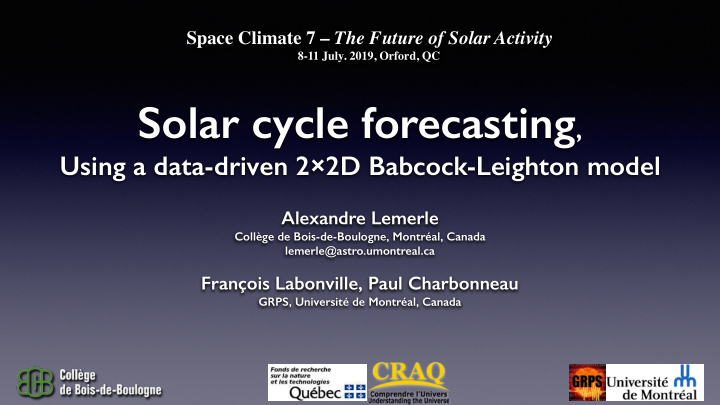



Space Climate 7 – The Future of Solar Activity 8-11 July. 2019, Orford, QC Solar cycle forecasting , Using a data-driven 2 × 2D Babcock-Leighton model Alexandre Lemerle Collège de Bois-de-Boulogne, Montréal, Canada lemerle@astro.umontreal.ca François Labonville, Paul Charbonneau GRPS, Université de Montréal, Canada
Solar cycle forecasting , Using a data-driven 2 × 2D Babcock-Leighton model • 2 × 2D Babcock-Leighton model design and calibration • Data driving • Predictability and calibration • Forecasting 4 Space Climate 7, 2019 lemerle@astro.umontreal.ca
Babcock-Leighton dynamo models • Phenomenological approach: « as simple as possible, but not simpler » • Directly based on observed solar surface features Dikpati & Gilman 2007 5 Space Climate 7, 2019 lemerle@astro.umontreal.ca
2 × 2D hybrid Babcock-Leighton dynamo model • 3 ~distinct mechanisms treated separately, with steady flows : 1. SFT module: MHD induction (magnetic flux "transport" ) at the surface (2D, non-axisymmetric) FTD module: MHD induction (flux "transport" ) in the meridional plane (2D, axisymmetric) 2. Destabilization / ascent / emergence of magnetic flux tubes (non axisymmetric) 3. 6 Space Climate 7, 2019 lemerle@astro.umontreal.ca
2 × 2D hybrid Babcock-Leighton dynamo model • 3 ~distinct mechanisms treated separately, with steady flows : 1. SFT module: MHD induction (magnetic flux "transport" ) at the surface (2D, non-axisymmetric) FTD module: MHD induction (flux "transport" ) in the meridional plane (2D, axisymmetric) 2. Destabilization / ascent / emergence of magnetic flux tubes (non axisymmetric) 3. Ferriz-Mas et al , 1994 6 Space Climate 7, 2019 lemerle@astro.umontreal.ca
2 × 2D hybrid Babcock-Leighton dynamo model • 3 ~distinct mechanisms treated separately, with steady flows : 1. SFT module: MHD induction (magnetic flux "transport" ) at the surface (2D, non-axisymmetric) FTD module: MHD induction (flux "transport" ) in the meridional plane (2D, axisymmetric) 2. Destabilization / ascent / emergence of magnetic flux tubes (non axisymmetric) 3. 7 Space Climate 7, 2019 lemerle@astro.umontreal.ca
2 × 2D hybrid Babcock-Leighton dynamo model 8 Space Climate 7, 2019 lemerle@astro.umontreal.ca
Model calibration / optimization 9 Space Climate 7, 2019 lemerle@astro.umontreal.ca
Model calibration / optimization 10 Space Climate 7, 2019 lemerle@astro.umontreal.ca
2 × 2D hybrid Babcock-Leighton dynamo model Lemerle et al, 2015 Lemerle & Charbonneau 2017 factor Adjustable « K » 11 Space Climate 7, 2019 lemerle@astro.umontreal.ca
Solar cycle forecasting , Using a data-driven 2 × 2D Babcock-Leighton model • 2 × 2D Babcock-Leighton model design and calibration • Data driving • Predictability and calibration • Forecasting 12 Space Climate 7, 2019 lemerle@astro.umontreal.ca
2 modes of BMR emergence FTD emergence function = ? ? ? => BMRs deposited in SFT 1. Data driven mode: deposit active regions taken from dataset on the solar surface while letting the internal field evolve correspondingly OR 2. Self-emergence mode: the model emerges its own population of active regions. 13 Space Climate 7, 2019 lemerle@astro.umontreal.ca
1. Datasets used for data-driving Yeates, 2016 dataverse.harvard.edu/dataverse/ solardynamo (maintained by Muñoz) Yeates et al, 2007 14 Space Climate 7, 2019 lemerle@astro.umontreal.ca
2. Self-emergence mode: BMR statistics FTD emergence function ==> BMRs deposited in SFT • probability of emergence proportional to B φ strength, etc => 2 ajustable parameters: B φ threshold & absolute number of emergences • at time & latitude, directly above the source B φ • tilt angle, bipole separation, magnetic flux extracted from probabilistic distributions… 15 Space Climate 7, 2019 lemerle@astro.umontreal.ca
2. Self-emerging mode: BMR statistics • inherent fluctuations associated with stochastic variations in BMR properties: => tilt angle, bipole separation and magnetic flux from probabilistic distributions… scatter = primary source of stochasticity in the regeneration of the surface dipole 16 Space Climate 7, 2019 lemerle@astro.umontreal.ca
Solar cycle forecasting , Using a data-driven 2 × 2D Babcock-Leighton model • 2 × 2D Babcock-Leighton model design and calibration • Data driving • Predictability and calibration • Forecasting 17 Space Climate 7, 2019 lemerle@astro.umontreal.ca
Predictability of solar activity • Procedure : - Start in mode 1: deposit active regions taken from databases - Switch to mode 2 : the model emerge its own population of active regions • Forecasting window: ~one cycle, when the emergence mode is switched at cycle minimum - Mode 1 Mode 2 Mode 1 Mode 2 18 Space Climate 7, 2019 lemerle@astro.umontreal.ca
Predictability of solar activity • But : effect of single extreme emergences (BMR) : Nagy et al, 2017 19 Space Climate 7, 2019 lemerle@astro.umontreal.ca
Data assimilation / calibration over cycle 24 • Adjust strength of initial condition (dipole) to reproduce end of cycle 23 • Adjust last model parameter ( dynamo number « K ») to reproduce cycle 24 23 24 20 Space Climate 7, 2019 lemerle@astro.umontreal.ca
Solar cycle forecasting , Using a data-driven 2 × 2D Babcock-Leighton model • 2 × 2D Babcock-Leighton model design and calibration • Data driving • Predictability and calibration • Forecasting 21 Space Climate 7, 2019 lemerle@astro.umontreal.ca
Forecasting cycle 25 • Ensemble forecast, with statistically independent realizations of active region parameters : - 1D+time: Sunspot number (SSN) - 1D+time: Axial dipole moment - 2D+time: Sunspot emergence lat-time map 23 24 25 22 Space Climate 7, 2019 lemerle@astro.umontreal.ca
Forecasting cycle 25 • Ensemble forecast, with statistically independent realizations of active region parameters : - 1D+time: Sunspot number (SSN) - 1D+time: Axial dipole moment - 2D+time: Hemispheric asymmetries 23 24 25 23 Space Climate 7, 2019 lemerle@astro.umontreal.ca
Forecasting cycle 25 24 Space Climate 7, 2019 lemerle@astro.umontreal.ca
Summary • A 2 × 2D hybrid SFT -FTD dynamo model right in the spirit of Babcock & Leighton ideas , « as simple as possible, but not simpler » (for the moment…) • Doubly-calibrated on the Sun: - surface flux transport vs magnetograms - emergence function vs observed butterfly diagram • Ready for real-time calibration through data assimilation • A forecasted cycle 25 : - rather short (~10 years) - slightly weaker than cycle 24 • long rising phase • weaker Southern hemisphere • delayed Northern hemisphere • room for a strong cycle 26 25 Space Climate 7, 2019 lemerle@astro.umontreal.ca
Recommend
More recommend